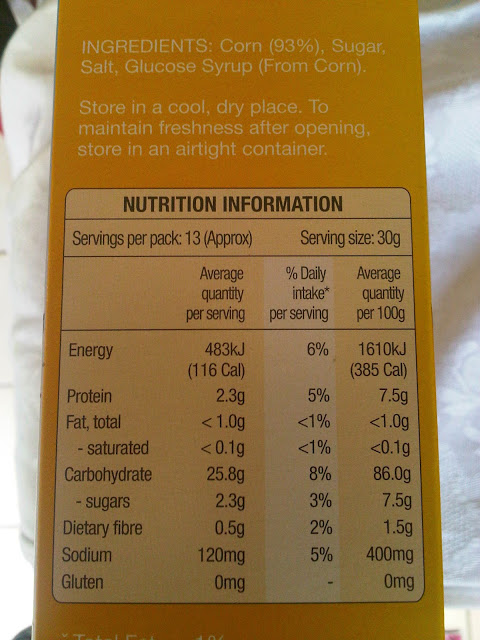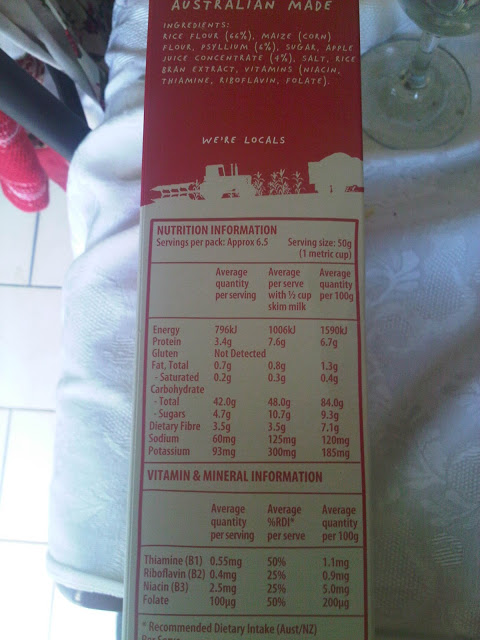If you've never read it, it's a good explanation of how to have a healthy, balanced diet.
Tonight we're doing something new. We're looking at reading food labels.
So here's two examples of breakfast cereals. (There's no point in comparing foods of different types - we're looking for different things in different types of foods.
Cereal A:
Cereal B
I'll actually take the boxes to the meeting to for people to look at tonight - but reading the information panel, is really all you need.
Firstly, let's look at the ingredients.
Cereal A: Corn (93%), Sugar, Salt, Glucose Syrup (From Corn).
The ingredients are ordered from greatest to least. So 93% of this is Corn. The other 7% is a mix of sugar and salt. Glucose is a form of sugar. (Point to note, anything ingredient ending in -ose is sugar.)
So mostly this cereal is just corn, with added sugar and salt for flavour. There's no artificial additives. There's also no added vitamins or minerals, and no ingredients high in fibre.
Cereal B: Rice Flour (66%), Maize (Corn) Flour, Psyllium (6%), Sugar, Apple Juice Concentrate (4%), Salt, Rice Bran Extract, Vitamins (Niacin, Thiamine, Fiboflavin, Folate).
There's a lot more ingredients in this. It still has two kinds of sugar (fruit juices are another way to include sugar, without calling it "sugar"). It also has salt, although we'll see later that it is much less salt than the other cereal. It has psyllium and rice bran extract, which both provide natural fibre.
It doesn't have artificial colours or flavours, but it does have added B group vitamins and folate (which is important to help the body absorb iron).
The Nutrition Information Panels
It's interesting to note, that each pack has three columns on the nutrition information panel.
Cereal A: has average quantity per serving, % of daily intake per serving, and average quantity per 100g.
The first thing to do here is ignore the middle column. This is % of daily intake for someone on an 8700kj per day diet. If you check your recommended intake on Calorie King you'll find that is very much more than recommended for women, especially women trying to lose weight.
Cereal B: has average quantity per serving, average per serve with 1/2 cup skim milk (the way you actually eat it) and average per 100g.
Comparing the two: You will notice that a serve of Cereal A is 483kj and a serve of Cereal B is 796kj, which makes it appear that Cereal B has more energy than Cereal A. This is just an appearance. If you look closer, you notice that a serve of B is 50g, while a serve of A is only 30g. For a fair comparison, we need to look at the average per 100g column of both - this is the one that is the same.
Serving sizes are set by the company making and marketing the product. They can be manipulated to make the product look better (ie by having a small serving size). This is a trick you'll see on a lot of products in the supermarket. A number of packages that look like single serves will actually have two "serves" according to the nutrition information panel. Be aware of the risk that you may be tricked.
For an accurate comparison of two foods of the same type, we need to line up the information in the 100g column side by side.
Cereal A Cereal B
Energy per 100g 1610kj 1590kj
Protein per 100g 7.5g 6.7g
Fat total per 100g <1g 1.3g
Saturated fat per 100g <1g .4g
Carbohydrate total per 100g 86.0g 84.0g
Sugars 7.5g 9.3g
Dietary Fibre per 100g 1.5g 7.1g
Sodium (salt) per 100g 400mg 120mg
What are we looking for when we look for healthy food?
We want the lower energy because we're trying to lose weight - Cereal B wins here, but not by a lot.
We want lower saturated fat - they're both quite low.
We want low sugar (but only because sugar is energy dense and increases the energy in food.) Cereal A wins here. Remember, the glycaemic index is far more important than whether the carbohydrate is sugar or starch, but neither of these cereals are marked with their GI.
We want high fibre. Fibre helps us feel full, and helps keep our bodies functioning effectively. Cereal B wins this by a long way.
And we want low salt, because although we all need a small amount of salt, most people eat far more than is healthy. Cereal B wins this one as well.
From comparing the two, I'd go with Cereal B for preference.
Now to serve it
We use the 100g (100ml for liquids) column of the nutrition information panel to compare products so we have a fair comparison.
When it comes to our actual serving, and recording it on Calorie King, it's time to use the actual serving size set - or to set your own serving size, but measure it, and tell Calorie King how much you've actually eaten.
You don't necessarily have to weigh and measure food every day, but doing it from time to time to ensure you still have a fairly good idea of what a serving size is, will make a huge difference to your weight loss. No matter how hard we work at checking that we are buying the very best food, if we are not actually paying attention to our portion sizes, we'll end up eating far more energy than our bodies can handle.
Note:
Our weight loss group uses calorieking.com.au which is a free site, or the Calorie King books which can be purchased fairly cheaply from most newsagents as the base for our program.



No comments:
Post a comment
Thanks for being part of the conversation.
Your comment will be visible after moderation.